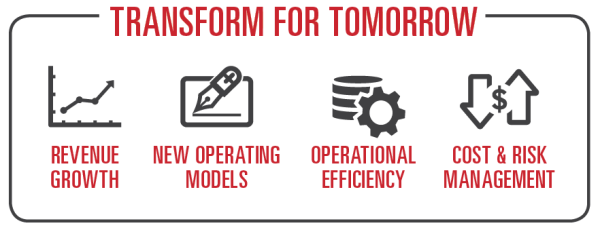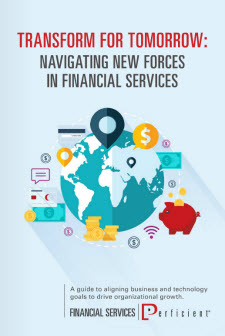New market forces and key drivers have forced financial services companies to redefine the way they do business with consumers and corporate clients. To enable long-term competitiveness, firms are thinking about new ways of thinking, innovation and executing winning business and technology strategies around: growth and profitability, new business models, risk management and efficiency and cost control.

Ongoing regulatory changes, new budgetary constraints and rapid advancements in digital technology are making it hard for financial firms to transform for tomorrow while managing the customer and operational challenges of today. Perficient recently published a new interactive digital guide, “Transform for Tomorrow: Navigating New Forces in Financial Services”, providing valuable insights and an outlook on the most important issues facing decision-makers within banks, mutual fund companies, capital market firms, hedge funds, private equity firms and insurance carriers.
Key Findings and Takeaways
Technology is considered to be one of the top enablers for transformation in financial services. Arguably, it can be a differentiator for firms in an increasingly competitive financial services landscape. Throughout the entire customer interaction lifecycle (Engage, Transact, Fulfill and Service), technology is at the core of business strategies designed to help firms interact with and better serve their customers. Keeping pace with technology advancements and consumer demand for new banking and financial services is an ongoing challenge. 
Back-office functions such as Human Resources, IT and Finance have been forced to refocus on cost reduction. As a result, financial services companies are evolving to more centralized operating models in the form of shared services to more strategically address regulatory compliance, engage and service customers, as well as enable the development of new products and services. Heading into next year, we’ll continue to see a heavy focus on long-term initiatives to support new operating models that will generate savings and improve operating performance. Firms are evaluating which functions can be outsourced, identifying global location strategies and maximizing the use of nearshore, offshoring or multishoring capabilities.
Evolving business needs, increased cost pressures and slow growth in new markets is making aligning operational efficiency with enabling technologies a critical area of investment for companies. Trading institutions are embracing low latency infrastructure and other practices to accelerate and improve trade lifecycle efficiency. Banks are rationalizing branch network performance and optimizing digital delivery channels. As a result, the stakes have never been higher, nor the opportunity greater, to employ new practices, tools and platforms to help firms overcome performance challenges.
A significant amount of financial IT spending is allocated to risk and compliance initiatives. This will continue to be the trend in the near-term for financial services companies, as firms look to leverage technology to control costs and better manage reputational, financial, operational and IT risk.
To learn more about these issues and how your organization can respond to these challenges with forward-thinking strategies and innovative technology solutions, download this new interactive and digital guide from our financial services industry experts.

